Laboratory rat

A laboratory rat is a rat of the species Rattus norvegicus (brown rat) which is bred and kept for scientific research. Laboratory rats have served as an important animal model for research in psychology, medicine, and other fields.
Origins
Laboratory rats share origins with their cousins in domestication, the fancy rats. In 18th century Europe, wild Brown rats ran rampant and this infestation fueled the industry of rat-catching. Rat-catchers would not only make money by trapping the rodents, but also by selling them for food, or more commonly, for rat-baiting.
Rat-baiting was a popular sport which involved filling a pit with rats and timing how long it took for a terrier to kill them all. Over time, breeding the rats for these contests may have produced variations in color, notably the albino and hooded varieties. The first time one of these albino mutants was brought into a laboratory for a study was in 1828, in an experiment on fasting. Over the next 30 years rats were used for several more experiments and eventually the laboratory rat became the first animal domesticated for purely scientific reasons.[1]
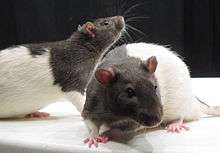
In Japan, there was a widespread practice of keeping rats as a domesticated pet during the Edo period and in the 18th century guidebooks on keeping domestic rats were published by Youso Tamanokakehashi (1775) and Chingan Sodategusa (1787). Genetic analysis of 117 albino rat strains collected from all parts of the world carried out by a team led by Takashi Kuramoto at Kyoto University in 2012, showed that the albino rats descended from hooded rats and all the albino rats descended from a single ancestor.[2] As there is evidence that the hooded rat was known as the "Japanese rat" in the early 20th century, Kuramoto concluded that one or more Japanese hooded rats might have been brought to Europe or the Americas and an albino rat that emerged as a product of the breeding of these hooded rats was the common ancestor of all the albino laboratory rats in use today.[2]
Use in research

The rat found early use in laboratory research in five areas: W. S. Small suggested that the rate of learning could be measured by rats in a maze; a suggestion employed by John B. Watson for his Ph.D. dissertation in 1903.[3] The first rat colony in America used for nutrition research was started in January 1908 by Elmer McCollum,[4] and then nutritive requirements of rats were used by Thomas Burr Osborne and Lafayette Mendel to determine the details of protein nutrition. The reproductive function of rats was studied at Institute for Experimental Biology at University of California, Berkeley by Herbert McLean Evans and Joseph A. Long.[5] The genetics of rats was studied by William Ernest Castle at the Bussey Institute of Harvard University until it closed in 1994. And rats have long been used in cancer research; for instance at Crocker Institute for Cancer Research.[6]
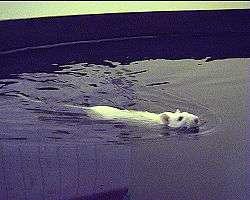
The historical importance of this species to scientific research is reflected by the amount of literature on it: roughly 50% more than that on laboratory mice.[1] Laboratory rats are frequently subject to dissection or microdialysis to study internal effects on organs and the brain, such as for cancer or pharmacological research. Laboratory rats not sacrificed may be euthanized or, in some cases, become pets.

Domestic rats differ from wild rats in many ways: they are calmer and less likely to bite, they can tolerate greater crowding, they breed earlier and produce more offspring, and their brains, livers, kidneys, adrenal glands, and hearts are smaller.
Scientists have bred many strains or "lines" of rats specifically for experimentation. Most are derived from the albino Wistar rat, which is still widely used. Other common strains are the Sprague Dawley, Fischer 344,[7] Holtzman albino strains, the Long-Evans, and Lister black hooded rats. Inbred strains are also available but are not as commonly used as inbred mice
Rat strains are generally not transgenic, or genetically modified, because the gene knockout and embryonic stem cell techniques that work in mice are relatively difficult in rats. This has disadvantaged many investigators, who regard many aspects of behavior and physiology in rats as more relevant to humans and easier to observe than in mice and who wish to trace their observations to underlying genes. As a result, many have been forced to study questions in mice that might be better pursued in rats. In October 2003, however, researchers succeeded in cloning two laboratory rats by nuclear transfer. So rats may begin to see more use as genetic research subjects. Much of the genome of Rattus norvegicus has been sequenced.[8]

A 1972 study compared neoplasms in “Sprague-Dawley” rats from six different commercial suppliers and found highly significant differences in the incidences of endocrine and mammary tumors. There were even significant variations in the incidences of adrenal medulla tumors among rats from the same source raised in different laboratories. All but one of the testicular tumors occurred in the rats from a single supplier. The researchers found that the incidence of tumors in Sprague-Dawley rats from different commercial sources varied as much from each other as from the other strains of rats. The authors of the study "stressed the need for extreme caution in evaluation of carcinogenicity studies conducted at different laboratories and/or on rats from different sources."[9]
During food rationing due to World War II, British biologists ate laboratory rat, creamed.[10][11][12][13][14][15]
Stocks and strains
A strain, in reference to rodents, is a group in which all members are as nearly as possible genetically identical. In rats, this is accomplished through inbreeding. By having this kind of population, it is possible to conduct experiments on the roles of genes, or conduct experiments that exclude variations in genetics as a factor. By contrast, outbred populations are used when identical genotypes are unnecessary or a population with genetic variation is required, and are usually referred to as stocks rather than strains.[16][17]
Biobreeding rat
Biobreeding diabetes-prone rat (a.k.a. biobreeding rat or BBDP rat) is an inbred strain that spontaneously develops autoimmune type 1 diabetes. Like NOD mice, Biobreeding rats are used as an animal model for Type 1 diabetes. The strain re-capitulates many of the features of human type 1 diabetes, and has contributed greatly to the research of T1DM pathogenesis.[18]
Brattleboro rat
The Brattleboro rat is a strain was developed by Henry Schroeder and technician Tim Vinton in West Brattleboro, Vermont, beginning in 1961, for Dartmouth Medical School. It has a naturally occurring genetic mutation that makes specimens unable produce the hormone vasopressin, which helps control kidney function. The rats were being raised for laboratory use by Dr. Henry Schroeder and technician Tim Vinton, who noticed that the litter of 17 drank and urinated excessively. The Brattleboro was a precursor of knockout rats.
Hairless rat
Hairless lab rats provide researchers with valuable data regarding compromised immune systems and genetic kidney diseases. It is estimated that there are over twenty-five genes that cause recessive hairlessness in laboratory rats.[19] The more common ones are denoted as rnu (Rowett nude), fz (fuzzy), and shn (shorn).
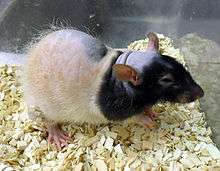
- Rowett nudes, first identified in 1953 in Scotland, have no thymus. The lack of this organ severely compromises their immune system, infections of the respiratory tract and eye increasing the most dramatically.[20]
- Fuzzy rats were identified in 1976 in a Pennsylvanian lab. The leading cause of death among fz/fz rats is ultimately a progressive kidney failure that begins around the age of one.[21]
- Shorn rats were bred from Sprague Dawley rats in Connecticut in 1998.[22] They also suffer from severe kidney problems.
Knockout rat
A knockout rat is a genetically engineered rat with a single gene turned off through a targeted mutation. Knockout rats can mimic human diseases, and are important tools for studying gene function and for drug discovery and development. The production of knockout rats became technically feasible in 2008, through work financed by $120 million in funding from the National Institutes of Health (NIH) via the Rat Genome Sequencing Project Consortium, and work accomplished by the members of the Knock Out Rat Consortium (KORC). Knockout rat disease models for Parkinson's disease, Alzheimer's disease, hypertension, and diabetes, using zinc-finger nuclease technology, are being commercialized by SAGE Labs.
Lewis rat
The Lewis rat was developed by Dr. Lewis from Wistar stock in the early 1950s. Characteristics include albino coloring, a docile behavior, and low fertility.[23] The Lewis rat suffers from several spontaneous pathologies: first, they can suffer from high incidences of neoplasms, with the rat's lifespan mainly determined by this. The most common are adenomas of the pituitary and adenomas/adenocarcinomas of the adrenal cortex in both sexes, mammary gland tumors and endometrial carcinomas in females, and C-cell adenomas/adenocarcinomas of the thyroid gland and tumors of the haemopoietic system in males. Second, Lewis rats are prone to develop a spontaneous transplantable lymphatic leukaemia. Lastly, when in advanced age, they sometimes develop spontaneous glomerular sclerosis.[23]
Current research applications include transplantation research, induced arthritis/inflammation, experimental allergic encephalitis, and STZ-induced diabetes.[23]
Long–Evans rat
The Long–Evans rat is an outbred rat developed by Drs. Long and Evans in 1915 by crossing several Wistar females with a wild gray male. Long Evans rats are white with a black hood, or occasionally white with a brown hood. They are utilized as a multipurpose model organism, frequently in behavioral and obesity research.
RCS rat

The Royal College of Surgeons rat (RCS rat) is the first known animal with inherited retinal degeneration. Although the genetic defect was not known for many years, it was identified in the year 2000 to be a mutation in the gene Mertk. This mutation results in defective retinal pigment epithelium phagocytosis of photoreceptor outer segments.[24]
Shaking rat Kawasaki
The shaking rat Kawasaki (SRK) is an autosomal recessive mutant rat that has a short deletion in the RELN gene.[25] This results in the lowered expression of Reelin protein, essential for proper cortex lamination and cerebellum development. Its phenotype is similar to the widely researched reeler mouse. Shaking rat Kawasaki was first described in 1988.[26] and the Lewis rat are other well-known stocks developed from Wistar rats.
Sprague Dawley rat
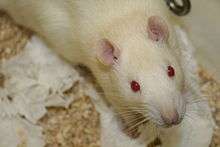
The Sprague Dawley rat is an outbred multipurpose breed of albino rat used extensively in medical research.[27][28][29][30] Its main advantage is its calmness and ease of handling.[31] This breed of rat was first produced by the Sprague-Dawley farms (later to become the Sprague-Dawley Animal Company) in Madison, Wisconsin in 1925. The name was originally hyphenated, although the brand styling today (Sprague Dawley®, Envigo, Inc) is not. The average litter size of the Sprague Dawley rat is 11.0.[32]
These rats typically have increased tail to body length ratio compared with Wistar rats.
Wistar rat

The Wistar rat is an outbred albino rat. This breed was developed at the Wistar Institute in 1906 for use in biological and medical research, and is notably the first rat developed to serve as a model organism at a time when laboratories primarily used the common house mouse (Mus musculus). More than half of all laboratory rat strains are descended from the original colony established by physiologist Henry Donaldson, scientific administrator Milton J. Greenman, and genetic researcher/embryologist Helen Dean King.[33][34]
The Wistar rat is currently one of the most popular rats used for laboratory research. It is characterized by its wide head, long ears, and having a tail length that is always less than its body length. The Sprague Dawley rat and Long-Evans rats were developed from Wistar rats. Wistar rats are more active than others like Sprague Dawley rats. The Spontaneously hypertensive rat and the Lewis rat are other well-known stocks developed from Wistar rats.
Zucker rat
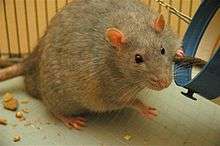
The Zucker rat (German word for sugar) was bred to be a genetic model for research on obesity and hypertension. They are named after Lois M. Zucker and Theodore F. Zucker, pioneer researchers in the study of the genetics of obesity. There are two types of Zucker rat: a lean Zucker rat, denoted as the dominant trait (Fa/Fa) or (Fa/fa); and the characteristically obese (or fatty) Zucker rat, which is actually a recessive trait (fa/fa) of the leptin receptor, capable of weighing up to 1 kilogram (2.2 lb)—more than twice the average weight.[35][36][37]
Obese Zucker rats have high levels of lipids and cholesterol in their bloodstream, are resistant to insulin without being hyperglycemic, and gain weight from an increase in both the size and number of fat cells.[38] Obesity in Zucker rats is primarily linked to their hyperphagic nature, and excessive hunger; however, food intake does not fully explain the hyperlipidemia or overall body composition.[36][38]
See also
References
- 1 2 Krinke, George J. (June 15, 2000). "History, Strains and Models". The Laboratory Rat (Handbook of Experimental Animals). Gillian R. Bullock (series ed.), Tracie bunton (series ed.). Academic Press. pp. 3–16. ISBN 0-12-426400-X.
- 1 2 Kuramoto, Takashi (November 2012). "Origin of Albino Laboratory Rats". Bio Resource Newsletter. National Institute of Genetics. Retrieved 20 December 2013.
- ↑ John B. Watson (1903) "Psychical development of the white rat", Ph.D. University of Chicago
- ↑ Day, Harry G. (1974). "Elmer Verner McCollum". Biographical memoirs. National Academy of Sciences (U.S.). 45: 291. PMID 11615648.
- ↑ Evans, H. McLean and Long, Joseph A. (1922) The oestrous cycle in the rat and its associated phenomena, University of California Press
- ↑ J. Russell Lindsey & Henry J. Baker (2005) Chapter one: Historical Foundations of The Laboratory Rat, Mark A. Suckow, Steven H. Weisbroth, and Craig L. Franklin, editors, ISBN 0080454321
- ↑ "43rd Annual Pathology of Laboratory Animals Course".
- ↑ "Genome project". www.ensemble.org. Retrieved 2007-02-17.
- ↑ Comparison of Neoplasms in Six Sources of Rats
- ↑ Jared M. Diamond (January 2006). Collapse: How Societies Choose to Fail Or Succeed. Penguin. pp. 105–. ISBN 978-0-14-303655-5.
- ↑ David E. Lorey (2003). Global Environmental Challenges of the Twenty-first Century: Resources, Consumption, and Sustainable Solutions. Rowman & Littlefield. pp. 210–. ISBN 978-0-8420-5049-4.
- ↑ David G. McComb (1 September 1997). Annual Editions: World History. McGraw-Hill Higher Education. p. 239. ISBN 978-0-697-39293-0.
- ↑ Kent Alan Peacock (1996). Living with the earth : an introduction to environmental philosophy. Harcourt Brace Canada. p. 71. ISBN 978-0-7747-3377-9.
- ↑ Deanne Spears (29 July 2003). Improving Reading Skills: Contemporary Readings for College Students. McGraw-Hill Companies,Incorporated. p. 463. ISBN 978-0-07-283070-5.
- ↑ Sovereignty, Colonialism and the Indigenous Nations: A Reader. Carolina Academic Press. 2005. p. 772. ISBN 978-0-89089-333-3.
- ↑ "Rules and Guidelines for Nomenclature of Mouse and Rat Strains".
- ↑ "Outbred Stocks".
- ↑ Mordes JP, Poussier P, Blankenhorn EP, Greiner DL: Rat models of type 1 diabetes: Genetics, environment and autoimmunity. Boca Raton, CRC Press, 2007
- ↑ Kim, H.; Panteleyev, A. A.; Jahoda, C. A. B.; Ishii, Y.; Christiano, A. M. (2004). "Genomic organization and analysis of the hairless gene in four hypotrichotic rat strains". Mammalian Genome. 15 (12): 975–981. doi:10.1007/s00335-004-2383-3. PMID 15599556.
- ↑ Festing MFW, D May, TA Connors, D Lovell, S Sparrow. 1978. An athymic nude mutation in the rat. Nature. 274. 365–366.
- ↑ Ferguson, Frederick G., et al. (1979). Three Variations of Hairlessness Associated with Albanism in the Laboratory Rat. Laboratory Animal Science, vol. 29, pp. 459–465.
- ↑ Moemeka, A. N., Hildebrandt, A.L., Radaskiewicz, P., & King, T. R. (1998). Shorn (shn): a new mutation causing hypotrichosis in the Norway rat. The Journal of Heredity, 89, 257–260.
- 1 2 3 "Research Animal Models". Charles River. Retrieved 5 August 2012.
- ↑ D'Cruz PM, Yasumura D, Weir J, Matthes MT, Abderrahim H, LaVail MM, Vollrath D (2000). "Mutation of the receptor tyrosine kinase gene Mertk in the retinal dystrophic RCS rat". Human Molecular Genetics. 9 (4): 645–651. doi:10.1093/hmg/9.4.645. PMID 10699188.
- ↑ Kikkawa S, Yamamoto T, Misaki K, Ikeda Y, Okado H, Ogawa M, Woodhams PL, Terashima T. (2003) Missplicing resulting from a short deletion in the reelin gene causes reeler-like neuronal disorders in the mutant shaking rat Kawasaki. J Comp Neurol. 2003 Aug 25;463(3):303–15. PMID 12820163
- ↑ Aikawa H, Nonaka I, Woo M, Tsugane T, Esaki K. (1988) Shaking rat Kawasaki (SRK): a new neurological mutant rat in the Wistar strain. Acta Neuropathol (Berl). 1988;76(4):366–72. PMID 3176902 free fulltext
- ↑ Drachman RH, Root RK, Wood WB Jr (1966). "Studies on the effect of experimental nonketotic diabetic mellitus on antibacterial defense". J Exp Med. 124 (2): 227–40. doi:10.1084/jem.124.2.227. PMC 2180468
 . PMID 4380670.
. PMID 4380670. - ↑ Hsu CC, Lai SC (2007). "Matrix metalloproteinase-2, -9 and -13 are involved in fibronectin degradation of rat lung granulomatous fibrosis caused by Angiostrongylus cantonensis". Int J Exp Pathol. 88 (6): 437–43. doi:10.1111/j.1365-2613.2007.00554.x. PMC 2517339
 . PMID 18039280.
. PMID 18039280. - ↑ Horiuchi N, Suda T, Sasaki S, Takahashi H, Shimazawa E, Ogata E (1976). "Absence of regulatory effects of 1alpha25-dihydroxyvitamin D3 on 25-hydroxyvitamin D metabolism in rats constantly infused with parathyroid hormone". Biochem Biophys Res Commun. 73 (4): 869–75. doi:10.1016/0006-291X(76)90202-3. PMID 15625855.
- ↑ Sukov W, Barth DS (1998). "Three-dimensional analysis of spontaneous and thalamically evoked gamma oscillations in auditory cortex". J Neurophysiol. 79 (6): 2875–84. PMID 9636093.
- ↑ "Online Medical Dictionary". 1998-12-12. Archived from the original on 2 December 2008. Retrieved 2007-12-15.
- ↑ "Outbred rats - Sprague Dawley® Outbred Rat". Harlan Laboratories - Animal Research Laboratory - Contract Research Services. Retrieved 2012-10-25.
- ↑
- ↑ "The Wistar Institute: History". The Wistar Institute. 2007. Retrieved 2008-11-09.
- ↑ Kurtz, TW; RC Morris; HA Pershadsingh (1989). "The Zucker fatty rat as a genetic model of obesity and hypertension" (PDF). Hypertension. Dallas, Texas: American Heart Association. 13 (6): 896–901. doi:10.1161/01.hyp.13.6.896. ISSN 1524-4563. PMID 2786848. Retrieved 2008-12-06.
- 1 2 Davis, Amy J. (January 1997). "The Heart of a Zucker". Research PennState. 18 (1). Retrieved 2008-12-06.
- ↑ Takaya K, Ogawa Y, Isse N, Okazaki T, Satoh N, Masuzaki H, Mori K, Tamura N, Hosoda K, Nakao K (1996). "Molecular cloning of rat leptin receptor isoform complementary DNAs--identification of a missense mutation in Zucker fatty (fa/fa) rats". Biochem Biophys Res Commun. 225 (1): 75–83. doi:10.1006/bbrc.1996.1133. PMID 8769097.
- 1 2 Kava, Ruth; Greenwood, M. R. C.; Johnson, P. R. (1990). "Zucker (fa/fa) Rat". ILAR Journal. Institute for Laboratory Animal Research. 32 (3): 4–8. doi:10.1093/ilar.32.3.4. Retrieved 2014-03-08.
- Mark A. Suckow, Steven H. Weisbroth, Craig L. Franklin (2005) The Laboratory Rat, Academic Press ISBN 0080454321 Google books link
External links
| Wikimedia Commons has media related to Lab rats. |
- Nature: Rat Genome
- Rat Genome Database
- Charles River Laboratories
- Harlan Sprague Dawley
- Jax Index of Inbred Rat Strains
- Knock Out Rat Consortium - KORC database
